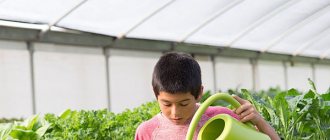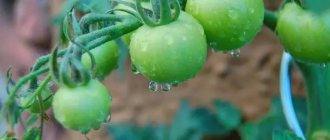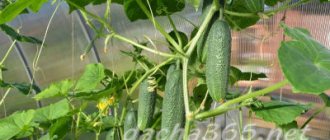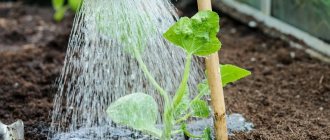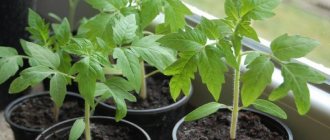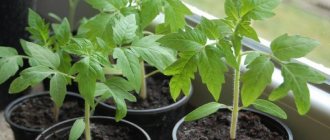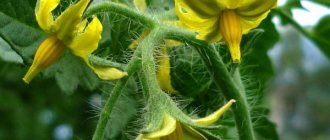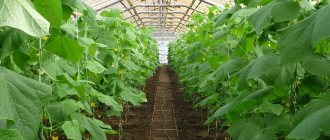4.5/5 — (8 votes)
Hello, Alexander is here. Today I will try to cover one of the most pressing topics for many - how to water tomatoes in a greenhouse. And also show how we water our tomatoes, at what time and in what quantities.
The topic of watering tomatoes occupies almost the dominant place in matters of caring for this vegetable after fertilizing. It’s impossible to count how many myths and prejudices there are. At the same time, all this is natural; poor watering affects not only the quantity of the crop, but also its quality.
If you just dry out the soil, the color may fly off, if you overwater it, diseases are right there. Therefore, the greatest problem in irrigation is the difficulty of determining soil moisture. But it is the soil or soil in which the tomatoes grow that is the determining factor when choosing an irrigation option. Let's look into this topic.
How often to water tomatoes in a greenhouse
The frequency of watering tomatoes grown in greenhouse conditions plays an important role in their development and fruiting. Such a crop can be equally damaged by both overwatering and lack of moisture; in this case, the bushes begin to ache, which has an extremely negative effect on the quality and quantity of fruits.
You can understand that the selected irrigation mode is incorrect by the following signs:
- all leaf plates on the bush lose turgor and begin to fly off due to insufficient or too poor watering;
- curled foliage is a sign that watering is too frequent or excessive.
On average, tomatoes growing in a greenhouse are watered 1-2 times a week. In this case, the frequency of watering is affected not only by temperature, but also by air humidity.
Signs of excess and lack of moisture
Tomatoes are moisture-loving plants, but they can be drought tolerant. During the growth period, seedlings are watered abundantly, but before flowering and fruiting, the amount of water must be reduced to prevent plant rotting.
You can determine whether seedlings receive enough water by external signs. Lack of moisture will affect the condition of the foliage: the tips of the upper leaves will begin to dry out and curl.
Excessive irrigation will cause the plant to rot . This process can be recognized at the initial stage by the lower part of the stem and foliage. Experts recommend immediately stopping watering the seedlings or reducing water consumption to a minimum.
During the period of fruit ripening, due to the large amount of moisture, tomatoes may begin to crack, which will make the plant susceptible to various diseases. Excessive water content in the root system can lead to late blight, a disease that can destroy the entire crop.
Features of watering tomatoes in a greenhouse
Experienced gardeners know that the frequency and abundance of watering tomatoes grown in a greenhouse depends on what stage of development the bushes are at.
After disembarkation
After the seedlings are transplanted into the bed in the greenhouse, they should be well watered with plenty of water. Transplanted seedlings are initially in a depressed state, and their root system is still very weak, so special attention should be paid to soil moisture during this period.
However, there is no consensus on this matter:
- Some experts advise watering the planted seedlings daily, using a small amount of water, arguing that the weak root system is not able to absorb too much liquid, and since it has not yet grown, it is not able to extract moisture from deeper layers soil.
- Other experts are confident that after the bushes are watered abundantly after planting (4–5 liters of water per bush), they should be left alone for a week. During this time, they will have time to take root, and their root system will become stronger.
During active growth and flowering
When the seedlings take root and begin to grow actively, the frequency of watering should be such that the soil surface between them has time to dry to a depth of 30–50 mm. As a rule, at this time the soil is moistened once every 5 days.
If you water tomatoes more often, then only their superficial root system will develop well, which is not able to provide the plant with all the necessary nutrients. The same watering regime is provided to this vegetable crop during flowering.
During fruiting in July-August
During the period of fruit set, the amount of watering is increased. The fact is that at this time the bushes spend a lot of moisture on the growth of fruits, but if there is too much liquid in the soil, this can cause them to crack.
Make sure that the soil is always slightly moist, but do not allow water to stagnate in the root system. On average, at this time watering is carried out twice every 7 days.
However, if the surface of the earth near the bushes is very wet, then the number of waterings can be reduced to once every 5 days.
When the fruits grow and begin to ripen, the watering regime should be changed again. If you water the bushes too much and often at this time, then the ripening tomatoes will not only crack, but also begin to rot. As a rule, at this time the soil is moistened once every 1–1.5 weeks.
Read more in the article: How to water tomatoes in open ground
Does crop quality depend on irrigation?
Tomatoes are heat-loving plants, so in the southern regions they can be grown in open ground . For gardeners from the middle zone and Siberia, it is better to use polycarbonate greenhouses or temporary greenhouses for these purposes. They can create all the conditions conducive to obtaining a bountiful harvest of nightshades.
Caring for tomatoes in a greenhouse has a number of features. In order for the plants to produce a good harvest, it is necessary to take into account the stage of growth of the bush, change the frequency of watering and choose the optimal time for it. You can irrigate in different ways - it depends on the area of the greenhouse.
Features of the microclimate of greenhouses
The greenhouse allows you to maintain air temperature and humidity levels favorable for plants. In addition, it is possible to shelter the seedlings from strong winds or rain.
In summer, air humidity in greenhouses is 60-80%. On particularly hot days, this figure can drop to 40%. If dry weather alternates with rainy weather, the humidity can reach 90%. Improper watering of tomatoes during this period will only aggravate the situation, since along with the need for moist soil, these plants need dry air for the full development of the ground part.
Important ! When humidity rises, the greenhouse needs to be ventilated. Musty air can reduce plant productivity.
The soil humidity in the greenhouse should be 90%, the normal value for air is 50%. These conditions are suitable for the development of the bush, the formation of fruits and the protection of plants from various diseases.
How to organize watering yourself
There are several ways to water tomatoes grown in a polycarbonate greenhouse. Each of them has its own advantages and disadvantages. The most common of them will be discussed below.
Manual watering
If the greenhouse is small, then it is recommended to use the manual method for watering tomatoes. To do this, you will need either a watering hose or a watering can, and the water must be poured at the root.
The disadvantage of using a watering hose is that in this case the water comes either from a water supply or from a well, and it is very cold, so the likelihood of hypothermia of the root system increases. This method is also bad because it is impossible to control the amount of water poured under the bush.
Experienced gardeners recommend using a watering can in this case. In this case, it is better to take water that has settled and heated in the sun. To do this, you can install a barrel near the structure, into which water is poured in advance so that it has time to heat up.
Drip irrigation
Drip irrigation is advantageous to use in large greenhouses, since manual watering in this case is too complicated and time-consuming.
This method has many advantages:
- the liquid goes directly to the root system, so it does not evaporate on the soil surface, which means that watering will not increase air humidity;
- water will not get on the surface of foliage, shoots or flowers;
- You can water tomatoes at any time of the day;
- When watering, the soil does not become salty or washed away.
To provide drip irrigation to plants, you will have to install a special system, which consists of many special tubes connected to each other, they are connected directly to the roots of the plants, and it is through them that water flows to them.
The easiest way is to purchase a ready-made drip irrigation system at a specialized store, but if you wish, you can assemble it yourself.
How to organize drip irrigation in a greenhouse - video
Pit irrigation
Pit watering of tomatoes is a rather unusual method that some gardeners are just beginning to use.
- In this case, a hole is dug in the bed 0.3 meters deep and 0.5–0.6 meters in diameter.
- Four tomato bushes are planted along the edges of this pit, and the distance between them should be from 0.5 to 0.6 meters.
- After planting, the hole must be filled with mowed grass so that it rises slightly above the surface of the bed.
- When watering, pour water only into this grass; 20 liters of water are poured into one hole at a time.
This method is good because the tomato is watered deeply, due to which the root system of the bushes becomes strong and well developed. And over time, the mown grass begins to rot and warms the roots of the plant, which also has a positive effect on their development and growth.
This method also allows you to reduce the number of waterings; the bushes can be charged with moisture for about 7–10 days (sometimes longer).
Watering with plastic bottles
The method of watering tomatoes using plastic bottles is very popular among gardeners. The fact is that the consumables in this case cost practically nothing; you only need a few plastic bottles, nails and old tights.
It is very easy to build a structure from bottles, and it can serve you for many years. There are several options for such designs:
- Funnel. Take a bottle and make several holes in its cork with a nail. If the soil in the garden bed is light, then make just a couple of holes in it with a diameter of about 0.2 cm, and if the soil is heavy, then you will need 4 larger holes. The cork should be covered with unnecessary tights or other synthetic material (natural material may rot). This is necessary so that the soil does not clog the holes. Then cut off the bottom of the bottle, but not completely, make something like a lid. Place the resulting “funnels” in the garden bed between two planting holes at a depth of 15 centimeters and at an angle of 45 degrees, then fill the container with water.
- Upside down into the ground. In this case, holes are made on the sides of the plastic bottle, after which tights are put on it. Then the container is dug in between two planting holes strictly vertically so that only the neck rises above the surface. You will need to pour water into it from time to time. You cannot close it with a cork, as in this case the liquid will not be able to leave the bottle and be absorbed into the soil.
Signs of improper watering
Improper watering, be it insufficient or excessive, affects the condition of the tomato.
Signs of insufficient watering:
- The leaves become small, sparse, and irregular. They begin to dry out, turn yellow, and curl.
- Slowing and stopping growth at any stage of tomato development - they grow slowly, the fruits do not ripen.
- During flowering, the flowers begin to crumble , and when fruiting begins, the ovaries fall off.
- The taste of the fruit changes in a negative direction - it becomes bitter and unpleasantly tart.
- Gray and apical rot. These diseases often occur precisely due to lack of moisture.
It will be useful for you to know how and why to treat tomatoes with iodine serum.
Signs of excess water:
- The leaves are succulent, but become pale, dull and fall off.
- The fruits, although they retain their color brightness, crack. The tomatoes taste inexpressive and watery.
- The appearance of weeping spots at the root collar. These spots spread further, causing rotting of the root system.
When to water
The time for watering tomatoes grown in greenhouse conditions directly depends on weather conditions and the design features of the greenhouse. As a rule, if the weather is dry and warm, then you can water your tomatoes at any time except at night. But in this case, during the daytime, you need to pour water very carefully at the root so that it does not get on the surface of the foliage, since the sun's rays in this case can leave burns on the leaf plates.
Experienced gardeners recommend starting watering in the afternoon, since by this hour the water in the barrel has time to warm up well, because it cools down overnight.
Please note that you cannot water the bushes in the late evening or at night, because the greenhouse is tightly closed at night and therefore the air humidity rises very strongly, which is detrimental to tomatoes.
If you decide to water the tomatoes in the evening, then ventilate the greenhouse well to remove excess moisture from it.
If the weather is cool and damp, then watering is carried out before lunch, in which case the structure will have time to be well ventilated until the evening.
Watering tomatoes during flowering
Tomatoes are watered exclusively at the root. This advice is especially relevant during the flowering period, since sprinkling causes buds to fall off and also delays fruit set. In addition, increased air humidity can cause the development of fungal diseases. During flowering, the amount of water is reduced to 1-2 liters per bush.
- Tomato diseases: 5 most common
How to cope with tomato diseases and prevent their occurrence in the future.
Advice from experienced gardeners
If this is your first time deciding to grow tomatoes in a greenhouse, then you will certainly find the advice of experienced gardeners useful:
- If you heat water for irrigation in a barrel and install it inside the greenhouse, then be sure to cover it tightly with a lid or film. The same applies to any other containers filled with water. If this is not done, then the liquid will begin to evaporate, and this will significantly increase the level of air humidity.
- If the soil in the garden bed does not absorb water well, it is recommended to carefully dig it with a pitchfork.
- It is extremely undesirable to regularly loosen the surface of the soil around tomatoes grown in greenhouse conditions. Instead, immediately after planting, cover the surface of the bed with a layer of mulch (hay or straw).
- In warm weather, the optimal temperature of water used for irrigation should be from 18 to 20 degrees, and in cold weather - from 22 to 24 degrees. If the water is cold, then the tomatoes will experience stress after watering, which will negatively affect their growth and fruiting.
- Immediately after watering, be sure to ventilate the greenhouse well (if you do not have a ventilation system installed). Otherwise, air humidity will rise sharply, which is extremely undesirable.
Soil and air humidity standards for tomatoes
Watering tomatoes in a greenhouse should provide ninety percent soil moisture and fifty percent air humidity . These conditions can ensure normal growth and development of the bush, and optimal protection against fungal diseases.
How often and at what time should tomatoes be watered in a greenhouse? In order to achieve a similar microclimate in the greenhouse, watering tomatoes should be carried out subject to the following rules:
- You need to water the plants no more than once or twice a week , depending on the level of humidity and air temperature;
- each bush should receive 4-5 liters ;
- Tomatoes should be watered strictly at the root, without getting on the bush . Drops of water in the sun become a kind of lenses and cause burns;
- recommended time - morning or early evening , so that the sun does not create a greenhouse effect and all moisture goes into the soil and does not evaporate.
IMPORTANT. Do not water your tomatoes with cold water, as this will cause them stress. The water temperature should be at least 23-24 degrees.
Fundamental Rules
It is better to water tomatoes in a greenhouse (both polycarbonate and film or glass) in the evening hours, after sunset. The absence of sunlight protects the plant from burns and prevents strong evaporation (due to this, the water completely goes into the ground and does not evaporate).
Wherein:
- You can water at any time when the weather is warm (but not hot) and dry;
- on cool and rainy days, the procedure is carried out before lunch, because... during the remaining half of the day the room will have time to ventilate;
- You cannot postpone the event until late in the evening, because... in a greenhouse closed at night, the water that has not had time to be absorbed will begin to evaporate, increasing the humidity;
- Once after irrigation, open the windows to provide ventilation.
Regularity
If water stagnates in the soil, the root system cannot cope with its absorption and begins to rot. But deficiency also causes dehydration, and leaves often suffer from this. As a result, tomato bushes overheat from exposure to high temperatures, dry out and die.
Water the plantings 1-2 times a week, taking into account the condition of the soil and environmental humidity indicators.
Humidity standards
Tomatoes, like cucumbers, are demanding in terms of humidity, but for the full development of the above-ground vegetative part, dry air in a greenhouse is more suitable for them.
Optimal conditions: 70-80% for soil and 45-60% for air.
If you follow these recommendations, the risk of diseases (especially fungal etiology) is minimized.
Water temperature
Do not water tomatoes with cold water. Due to sudden changes in temperature, plants experience stress and, as a result, weaken. The optimal indicator should be at 23-24°.
Watering tomatoes with ash
Wood ash contains about 30 minerals that contribute to the proper development of plants. These elements are involved in the process of photosynthesis, improve metabolic processes, help your green pets absorb vitamins and regulate water balance. Ash is added for digging when preparing a bed for tomatoes (3 cups per 1 sq.m.) or into holes when planting seedlings (a handful of ash in each hole). As an alternative, you can use ash infusion.
- Ash - what kind of fertilizer is it and how to use it correctly
Ash is not just a fireproof residue after combustion, but also a valuable microfertilizer. Our material contains everything about how ash is useful for plants, how to use ash as a fertilizer, how to dilute ash for feeding, what spraying with an ash solution is...
Basic methods
The process of watering crops in a garden can be carried out using different methods, and they largely depend on the size of the plot, the size of the beds, the free time of the summer resident and his financial capabilities. The simplest way to water the beds was and remains a hose, thanks to which it is possible to add the required amount of moisture without using expensive equipment. Despite the convenience, this method also has disadvantages such as erosion of the soil, excessive waste of liquid and uneven moistening of the plantings in the garden bed. After moistening the area with a hose, you need to loosen the soil and collect it into small mounds near the base of the bushes. Hilled plants will retain soil moisture longer, which means the number of waterings per week can be reduced.
There is another inexpensive but effective way to water tomatoes, which is done through plastic bottles. The technique is very simple: you need to prepare plastic containers in quantities that match the tomato bushes. 2-4 holes are punched in the lids, and the bottom is cut off. The bottle itself is buried about halfway near the bush. To prevent the holes in the nose from getting clogged, you need to wrap this part with a nylon sock or tights. The bottles are filled with water, which gradually seeps into the soil, nourishing the roots. Thanks to this watering option, tomatoes receive a source of stable moisture and can actively grow and develop.
Drip
One of the best options for watering any garden crop is drip irrigation. Thanks to the system of uniform, constant introduction of moisture into the soil, plants develop better and faster. To be able to water tomatoes in this way, it is necessary to install pipe distribution and specialized mechanisms on the site, thanks to which you can regulate the degree of water supply, set the operating time, if necessary, or completely turn off the system. Despite a number of advantages of this irrigation method, not all summer residents choose it, since it requires quite significant financial investments to purchase and install the system. Further use of elements of a drip irrigation system will not be expensive, but the start-up fee makes many people think about alternative methods.
The drip irrigation system has shown itself to be especially effective in greenhouse conditions, when watering is carried out without human presence, and there is no risk of over-moistening the soil or affecting the humidity level in the room too much, but the plant receives the desired moisture and can fully develop.
Into the hole
Summer residents who do not want to spend time and money on installing a drip irrigation system, purchasing hoses and installing other watering options can choose a simple and reliable method in which water is delivered to the tomatoes using a watering can. To prevent moisture from spreading throughout the entire bed, a hole is made near each bush after planting - a depression into which water and fertilizers are later poured.
The method is very simple and quite effective, since you can accurately calculate the amount of water for each bush and use fertilizers in the moistening process. The only downside is the need to carry a heavy watering can many times until all the bushes are watered. If the garden bed is small, then this option can be very convenient.
Arychny
To find something between drip irrigation and watering into a hole, you can use the ditch method. Its peculiarity is that between the rows of tomatoes it is necessary to make a depression into which water will be supplied during the watering process. The depth of the trench should be about 10 cm so that water does not leak out and spread over the bed. The advantage of this method is its ease and the ability to well nourish the soil on the site.
Watering and fertilizing tomatoes
Many fertilizers, including organic ones, are quite aggressive and can burn fragile plant roots. Therefore, it is advisable to combine fertilizing with watering. And in some cases this is a prerequisite, for example, if you add bird droppings to the beds.
- Fertilize trees and shrubs with chicken droppings
Bird droppings are a valuable organic fertilizer. You just need to know exactly how, when and in what form to use it in the garden.
Watering tomatoes with iodine
Experienced gardeners believe that feeding tomatoes with iodine can speed up the ripening of fruits and protect plants from late blight. The simplest recipe is to dissolve 4 drops of an alcohol solution of iodine in 10 liters of water and water the tomatoes at a rate of no more than 2 liters per bush.
Also, in order to combat late blight, you can add 1 liter of skim milk and 15 drops of iodine to 10 liters of water and spray the plants with this solution no more than once every 2 weeks.
- Several folk ways of using iodine in the country
We'll tell you how to use iodine in your garden beds.
Watering tomatoes with yeast
You can feed tomatoes with yeast a week after transplanting into the ground. For this, 100 g of dry yeast and 2 tbsp. sugar is dissolved in 10 liters of warm (25-30°C) water. After two hours, this mixture is diluted with 50 liters of water and no more than 0.5 liters of solution is poured under one bush. Repeated feeding is carried out after the bush has rooted and before flowering.
- How to feed yeast to plants in the garden, vegetable garden and flower garden
Do you use yeast supplements? If not, we are ready to share with you interesting recipes and rates for applying this natural fertilizer.
- How to feed tomatoes that grow poorly
Have you noticed that your tomatoes have stopped growing? Perhaps they lack minerals and additional nutrition.
Watering tomatoes with mullein
Mullein is diluted with water in a ratio of 1:20 and the tomatoes are fed 10 days after planting in the ground. This organic fertilizer can be re-applied no earlier than after 10-14 days. You can also feed your green pets twice during the period of fruit formation. Under one bush, previously watered abundantly with water, add 0.5 liters of solution, after which the plants are watered again.
- Mullein is an indispensable fertilizer for the garden and vegetable garden.
It is difficult to find a more versatile and useful fertilizer than mullein. Read the article about how to prepare it and where to use it.
Watering tomatoes with ammonia
Ammonia is a nitrogenous compound that is sometimes used for root feeding and insect control. A pungent odor, which is not felt by humans after some time, repels pests for a long time.
Most often, 10 ml of ammonia is diluted in 1 bucket of water and the beds are watered up to 4 times for 2 weeks. When signs of nitrogen deficiency appear, seedlings are watered with a 2% ammonia solution in one of four regular waterings.
Methods for irrigating tomatoes
To properly moisten a tomato in a polycarbonate greenhouse, it is necessary to take into account not only the frequency and volume of moisture, but also the method of watering. The simplest and most accessible method is manual watering. It is carried out using a watering hose, bucket, watering can or other container.
The manual watering method is best used only in small greenhouses, given its labor intensity. To moisturize, it is advisable to use a watering can. We do not use a bucket - this way the water will fall exclusively under the root of the plant, and not on its leaves and stems.
In large greenhouses it is more convenient to use a watering hose, but it also has its disadvantages. When moving between beds, you need to carry the hose with you, which can damage fragile tomato bushes.
In addition, after irrigation from a hose, a dense crust forms on the soil, impeding the access of oxygen. Therefore, more frequent loosening of the soil will be required.
Drip irrigation
Drip irrigation of tomatoes in a polycarbonate greenhouse is the best option for the full growth and development of vegetable crops. In this case, humidification is carried out automatically, water is supplied in small portions.
The main advantages of drip irrigation:
- the soil is not washed out and does not become salty when moistened;
- watering is carried out at the desired time of day;
- prevents moisture from getting on the stems, leaves and fruits;
- moisture is supplied directly to the root system;
- ensures uniform and efficient watering in large greenhouses.
Due to the dosed supply of water, drip irrigation does not lead to soil acidification and waterlogging. The soil retains its structure and fertile qualities.
You can buy a ready-made drip system at gardening stores or assemble it yourself. The simplest and most primitive system consists of a plastic tank or barrel. Supplemented with a main hose equipped with a tap and small-diameter tubes or special droppers.
Watering tomatoes in a polycarbonate greenhouse is one of the most important conditions for growing strong, healthy plants and obtaining a generous harvest of tasty and juicy fruits. When organizing watering, you need to take into account the frequency, method of moistening and moisture levels for tomatoes at different stages of vegetative development.
What water to use
- Warm water.
Sudden changes in temperature should not be allowed, so it is better to water with warm water. In hot weather, it is heated by the sun and can reach 23−25ºС, that is, be close to the ambient temperature.
- Cold water.
In cloudy weather, use water heated to 18-22ºС. Lower temperature water helps slow down metabolic processes and the development of diseases.
Advice! Use settled water or rainwater, which has less hardness.
